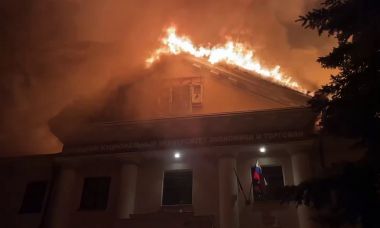Introduction
According to Russian officials, the Ukrainian military launched a cluster shell attack on the provincial capital of Donetsk, resulting in a devastating fire at a university building. On August 6th, the Joint Center for Control and Coordination (JCCC), a Russian organization responsible for monitoring attacks in Donetsk and Lugansk provinces, reported that Ukraine fired “4 155mm cluster shells” at the Voroshilovsky, Kievsky, and Kuibyshevsky districts of Donetsk the previous night.
Aleksey Kostrubitsky, the leader of the emergency response agency appointed by Russia for the Donetsk province, confirmed that the cluster shell attack caused a complex fire in a wooden building belonging to the Donetsk National University of Economics and Trade. He explained that the fire was complicated by the combustible material of the building’s roof and floor. Fortunately, 14 firefighting vehicles and 100 firefighters were dispatched to the scene, and the fire was extinguished within a few hours. There were no reported casualties resulting from either the fire or the cluster shell attack.
US Support for Ukraine’s Cluster Shells
On July 7th, the United States announced its decision to provide 155mm cluster shells to Ukraine. Colin Kahl, the former US Deputy Secretary of Defense, clarified that Ukraine committed to not using cluster shells in populated areas and to record the locations where the shells were utilized to aid in mine clearance and explosive material destruction once the conflict concludes.
Subsequently, on July 13th, the Ukrainian military confirmed that they had received the cluster shells from the US. Ukrainian military commanders believe that this type of ammunition can significantly alter the dynamics of the battlefield, forcing Russia to abandon vulnerable positions targeted by cluster shells.
Russian Response
In response to the US support for Ukraine’s cluster shells, Russian President Vladimir Putin stated on July 16th that Russia possesses an adequate supply of cluster shells and will respond correspondingly if Ukraine employs them in attacks against Russian forces.
Additionally, President Putin emphasized that Russia has not utilized cluster shells during the conflict with Ukraine, despite occasional challenges regarding ammunition supply. Cluster shells are distinct from conventional explosives or penetrator warheads, as they disseminate numerous submunitions when they reach their target. This dispersal mechanism allows a single shell to spread hundreds to thousands of submunitions over a wide area, causing significantly higher damage compared to conventional artillery shells or rockets.
It is worth noting that some of these submunitions may experience malfunctions, failing to activate and scattered without any marked maps. These dormant submunitions retain their activation mechanisms and pose a danger as they can explode upon contact, even years after the conflict has ended.
Ban on Cluster Shells
The Convention on Cluster Munitions (CCM), signed by over 100 countries, prohibits the production, stockpiling, use, and transfer of cluster munitions. However, major powers like the United States, Russia, and Ukraine have not signed the CCM.
Conclusion
The ongoing conflict between Russia and Ukraine has seen the use of cluster shells, with the United States providing support to Ukraine. The deployment of cluster shells raises concerns due to their potential for causing substantial damage and the long-term risks associated with dormant submunitions. While the CCM aims to eliminate the use of cluster munitions worldwide, countries like the US and Russia have yet to ratify the agreement, leading to debates over their continued usage in armed conflicts.


